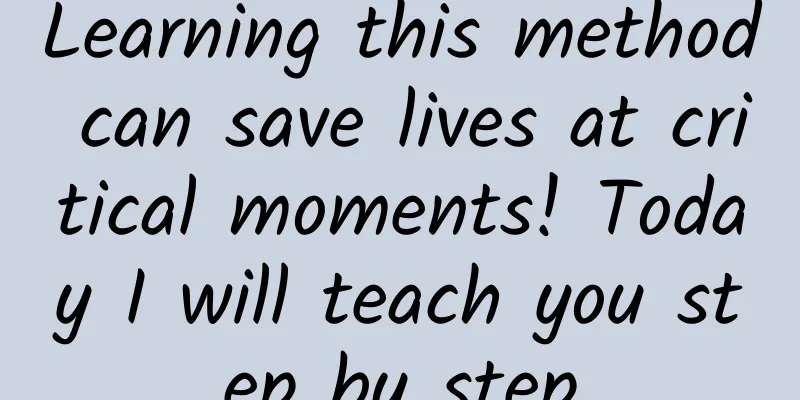Learning this method can save lives at critical moments! Today I will teach you step by step

|
Speaking of CPR Many people feel familiar yet strange Know that this is the main means of rescuing cardiac arrest But if you really want to do it yourself I still feel uneasy: Is artificial respiration necessary during cardiopulmonary resuscitation? What should I do if my ribs are broken due to excessive chest compressions ? Can you stop during compression to check if the patient has recovered his breathing? Today, Dr. Huaxi will teach you this first aid skill step by step, which can save lives at critical moments ! Performing cardiopulmonary resuscitation within 6 minutes after cardiac arrest is the golden time to save lives! Because after the heart stops beating, if there is no immediate rescue and resuscitation, the body's vital organs and tissues will suffer irreversible damage after 4 to 6 minutes, and brain death will occur after more than 10 minutes. Image source: Photo Network In short, the sooner the rescue measures after cardiac arrest, the better! The steps of CPR include : ● Check and ensure the safety of the on-site environment; ● Check whether the collapsed patient’s breathing and circulation are abnormal; ● Ask people around to help call "120" and another person to find an AED; ● Perform cardiopulmonary resuscitation by performing chest compressions and artificial respiration; ● Use defibrillator, etc. Image source: Photo Network The key to correct chest compression is to do these 7 things: ①Put the patient in the recovery position . Turn the patient to the rescuer's side so that the patient lies on his back, and then align his head, neck, shoulders, waist, and hips in a straight line. The rescuer kneels on either side of the patient's body, with his knees apart, shoulder-width apart, and his shoulders facing the patient's sternum, about one fist away from the patient's body. ②Place the base of one hand on the center of the patient's chest, with the middle finger pressed on one nipple, and the base of the palm placed at the midpoint of the line connecting the two nipples , not to the left or right. Place the base of the other hand on the back of the first hand, with the fingers of both hands interlocked, making sure that the fingers do not touch the ribs. Image source: Photo Network ③Use your hip joint as a fulcrum, keep your arms basically vertical, and press in the direction perpendicular to your sternum each time. Then use the strength of your upper body to press down hard, with an average pressing depth of 3 to 5 cm . After each press, wait until the chest cavity fully rebounds and expands before pressing again. At the same time, the base of your palm should never leave the chest wall to ensure the accuracy of the position. Image source: Made by myself ④ The frequency of compression should be maintained at 100 to 120 times per minute , and then "press and relax" continuously for 30 times at this frequency, with an even rhythm, and the time for compression and relaxation and rebound should remain the same. ⑤ Open the airway . First, clear the foreign objects in the mouth and choose the "forehead pressure and jaw lift method" or "two-handed jaw support method" to keep the patient's airway open. ⑥ Mouth-to-mouth artificial respiration . The rescuer should pinch the patient's nose to open his mouth, tightly cover the patient's mouth with his mouth, and blow air into the patient's mouth until his chest bulges, and maintain it for 1 to 2 seconds . When blowing, the chest rises significantly, and the chest falls back after the mouth is removed, forming an effective artificial respiration. Image source: Photo Network Repeat the above steps and perform two effective artificial respirations in a row. After performing two effective artificial respirations, you need to perform 30 chest compressions again, with a ratio of 30:2 for 5 cycles, and then recheck the patient's breathing and circulation signs . Be careful not to blow for too long, which will compress the lungs, reduce lung ventilation, and may cause reflux of gastric contents to block the airway. ⑦ Rescuers take turns performing chest compressions and artificial respiration until the patient's heartbeat recovers or the "120" emergency personnel take over . AED (Automated External Defibrillator) is the full name of automatic external defibrillator. When performing cardiopulmonary resuscitation, simple pressing cannot terminate ventricular fibrillation. The use of AED for electric shock defibrillation can restore the heart to normal rhythm and greatly improve the success rate of treatment . AED can be seen in many public places. It comes with its own battery and is very easy to use. After turning it on, the rescuer only needs to follow the voice prompts and screen instructions step by step . Image source: Photo Network 1 open Take out the AED and press the power button to turn it on. The patient lies in supine position and the AED is placed on the patient's head. It is usually operated on the patient's left side to facilitate cardiopulmonary resuscitation on the patient's right side. 2 stick ① Untie or cut open the patient's clothes on his chest and wipe off the sweat on his chest with a dry cloth . ② After hearing the AED voice prompt "Apply the electrodes to the patient's skin", remove the film on the electrodes, apply the right electrode to the patient's upper right chest, and the left electrode to the patient's left armpit . When sticking the electrodes, be accurate and quick to minimize the interruption time of manual cardiopulmonary resuscitation . Image source: Photo Network 3 Insert After hearing the AED voice prompt "Insert the electrode plug into the jack next to the flashing light", plug it into the AED host interface. The AED will automatically start analyzing the heart rhythm for 5 to 15 seconds . Artificial first aid should be stopped at this time and all personnel at the scene should not come into contact with the patient . 4 electricity If defibrillation is recommended, make sure no one is touching the patient and press the PELAS key . After a defibrillation, cardiopulmonary resuscitation (chest compressions and artificial respiration) should be continued immediately and repeated until emergency personnel arrive. If the AED analysis does not require defibrillation, continue CPR . The operation of AED is very safe. The rescuer only needs to follow the voice prompts without worrying about being electrocuted. Successful defibrillation can give you a greater chance of saving the patient's life . 1 Is it necessary to perform artificial respiration during cardiopulmonary resuscitation? answer Not entirely. In the first few minutes of cardiac arrest, the oxygen in the blood is still sufficient, and it is okay to continue chest compressions. Artificial respiration is not necessary . 2 What should I do if I break my ribs due to excessive chest compressions? answer Indeed, during the rescue process, the patient's ribs may be broken due to the force. However, when the patient suffers cardiac arrest, we need to focus on saving his life. The compression needs to be at a certain depth . We cannot delay the rescue work for fear of breaking ribs and fail to perform the compression well. 3 Can I stop during compression to check if the patient has resumed breathing? answer "The golden 6 minutes, don’t stop pressing"! It is okay to observe the patient's reaction during compressions, but you cannot stop performing cardiopulmonary resuscitation with both hands . Any stopping action will waste rescue time and is unnecessary and undesirable. Love life, save it by your side Proper CPR skills are crucial Please spread it quickly Let more people see it~ Statement: This article is a medical-related educational popular science article. It does not involve specific treatment methods or medical behaviors and cannot replace hospital visits. This article's cooperating technician References 1. Liu Yangyang, "Rescue is at your side. Do you know CPR?", 1994-2024 China Academic Journal Electronic Publishing House, Friends of Science 2024:35 2. Shi Qinghua/Yu Xiya, Cardiopulmonary Resuscitation, “Rescue” at Your Side, 1994-2024 China Academic Journal Electronic Publishing House, 2024:83 3. Li Jingmei, editor-in-chief, Illustrated Handbook of Family First Aid Knowledge, Tianjin Publishing and Media Group, 2021:038-041 4. Zhen Tao, "AED: A life-saving device at critical moments", 1994-2024 China Academic Journal Electronic Publishing House, "Health for All", Issue 02, 2024:46-47 5. First aid science popularization - "Life-saving artifact" - AED (Automated External Defibrillator)", Qiongtai Normal University, 2021-11-11 Content Production Editor: Yang Yali Map: Eastern Zhou Dynasty |
<<: Amazing Oracle: Are rabbit and rabbit just a little bit different?
>>: Can the ketogenic diet starve cancer cells to death and help anti-cancer drugs eliminate tumors?
Recommend
Smart Internet dominates cars? Anyway, I don’t believe it
Ever since display screens appeared on car center ...
How to achieve product growth and acquire and retain users at low cost?
In March 2017, Coca-Cola announced that it would ...
What are the functions of Lanzhou home furnishing and building materials mini program? How much does it cost to develop a building materials distribution mini program?
In recent days, we have received a lot of inquiri...
Android and Chrome merge, a win-win for developers and Google
[[122279]] For a long time, developers have often...
The O2O showdown between Dianping and Meituan: Platform vs. self-operated
Dianping and Meituan, which started out as mercha...
Luo Yonghao reviews four flagship phones: Xiaomi's camera is not as good as Huawei's Nut R1, and the overall experience is the best
[Smart Observation Report] In the past two days, ...
Never flooded for more than 600 years! Why is the Forbidden City not afraid of heavy rain?
Review expert: Wang Shengwei, Senior Engineer, Be...
Apple iOS 13's new features will always give you a refreshing feeling
2019 has passed, and it has been almost a month s...
Android decompilation - smali syntax
Preface We have talked about the tools for androi...
How to do UGC operation? Sort out these 3 points!
UGC has been recognized as a way to improve produ...
Inventory of classic running video types in information flow
Everyone should be familiar with the financial in...
WeChat group traffic diversion and operation methods!
Nowadays, many people believe that WeChat groups ...
Toyota Motor Financial Report: Toyota's net profit in Q3 of fiscal year 2024 was 573.7 billion yen, a year-on-year decrease of 55%
Japanese automaker Toyota said on Monday its prof...
Today is National Cancer Day. Early screening for these four types of cancer is really useful!
Today is April 15th, also National Cancer Day. No...
"Perfect Diary" content marketing model!
The rapid popularity of Perfect Diary , a domesti...









